Lo spostamento del sito WordPress su un nuovo dominio è un passo importante che necessita di un’attenta pianificazione. Modificare il nome del dominio può influire sulle classifiche SEO, quindi è essenziale gestire il processo con cura.
Abbiamo affrontato con successo il processo di modifica del dominio numerose volte, quindi conosciamo in prima persona le potenziali insidie e sappiamo come evitarle.
Sebbene le fluttuazioni temporanee della SEO siano inevitabili durante una migrazione di dominio, è possibile ridurne l’impatto. Con il giusto approccio, sarete in grado di recuperare rapidamente il vostro traffico di ricerca e le vostre classifiche.
In questa guida vi illustreremo il modo corretto per spostare WordPress su un nuovo dominio senza perdere la SEO.
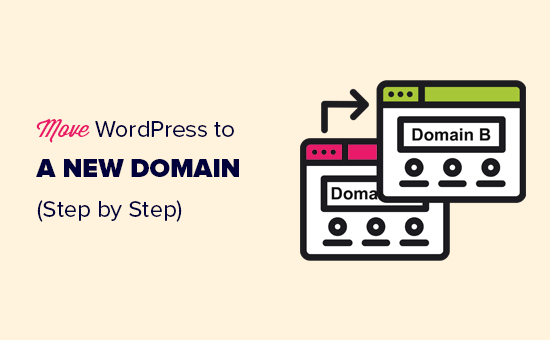
La migrazione del vostro sito WordPress a un nuovo nome di dominio può essere spaventosa, ma non deve esserlo per forza. Siamo qui per accompagnarvi in ogni fase del processo.
Potete fare clic su uno qualsiasi dei link sottostanti per passare a una fase specifica della migrazione del vostro sito WordPress a un nuovo nome di dominio:
- What to Know Before You Change Domains
- Pre-Steps: What You Need to Get Started
- Step 1: Create a Duplicator Package of Your WordPress Site
- Step 2: Create a Database for Your New Domain Name
- Step 3: Unpack WordPress on Your New Domain Name
- Step 4: Set Up Permanent 301 Redirects
- Step 5: Notify Google About Your New Domain
- Notify Your Users About the New Domain Name
- Video Tutorial
Cosa sapere prima di cambiare dominio
Prima di iniziare, ci sono alcune cose da sapere.
Il processo di trasferimento a un nuovo dominio influenzerà temporaneamente il posizionamento sui motori di ricerca, poiché Google e gli altri motori di ricerca dovranno adattarsi alle modifiche.
Ciò influirà temporaneamente anche sul vostro traffico di ricerca. NON SI TRADUCE: si tratta di una situazione normale, che capita a tutti i siti web che passano a un nuovo dominio.
Tuttavia, potete ridurre drasticamente l’impatto SEO seguendo questa guida. Vi mostreremo il modo giusto per spostare il vostro sito WordPress su un nuovo nome di dominio, impostare i reindirizzamenti 301 corretti e informare i motori di ricerca.
Si noti che questa guida non serve a spostare un sito WordPress su un nuovo host. Si tratta solo di cambiare un nome di dominio. Anche se il processo è simile, ci sono alcuni passaggi in più. Questi passaggi extra vi aiuteranno a proteggere le vostre classifiche SEO e il vostro traffico.
Infine, se il vostro vecchio sito è su WordPress.com, dovete seguire le istruzioni della nostra guida su come passare da WordPress.com a WordPress.org.
Passi preliminari: Cosa serve per iniziare
In questa guida si presuppone che il sito web WordPress sia impostato su oldsite.com e che si stia cercando di migrarlo su newsite.com.
Si presume inoltre che abbiate già un account di hosting WordPress e che abbiate familiarità con il pannello di controllo del vostro web hosting.
Dovrete anche sapere come utilizzare un client FTP come FileZilla o come modificare i file utilizzando l’applicazione File Manager disponibile nella dashboard del vostro account di hosting.
Nel caso in cui non abbiate un provider di web hosting o stiate cercando di passare a uno nuovo, vi consigliamo di utilizzare Bluehost (ottimo per i piccoli siti e con un dominio gratuito) e SiteGround o WP Engine (ottimi per i siti più grandi o i negozi online).
Una volta che questi elementi sono a posto, siete pronti per iniziare il processo!
Passo 1: Creare un pacchetto duplicatore del vostro sito WordPress
La prima cosa da fare è creare un backup completo del vostro sito WordPress.
Utilizzerete quindi questo backup per creare un duplicato del vostro sito web, in modo da poter impostare correttamente i reindirizzamenti dal vecchio dominio a quello nuovo.
Sebbene esistano molti plugin per il backup di WordPress, in questo tutorial utilizzeremo Duplicator.
Duplicator è il miglior plugin per il backup e la migrazione di WordPress. Lo abbiamo utilizzato per migrare innumerevoli siti web per le nostre aziende e per i nostri clienti. Abbiamo constatato che funziona in modo affidabile, anche per siti web molto grandi.
Nota: è disponibile anche una versione gratuita di Duplicator, che può essere utilizzata per questa migrazione. Tuttavia, si consiglia di passare a un piano a pagamento per sbloccare altre caratteristiche come i backup automatici nel cloud, il ripristino del sito web in un clic, migrazioni più semplici e altro ancora.
Iniziamo installando e attivando il plugin Duplicator sul vecchio nome di dominio. Per maggiori dettagli, consultate la nostra guida passo-passo su come installare un plugin di WordPress.
Una volta attivato, il plugin aggiungerà una voce di menu Duplicator nell’amministrazione di WordPress. È necessario andare alla pagina Duplicator ” Backups e fare clic sul pulsante ‘Create New’ per creare un nuovo backup o una copia del sito WordPress.
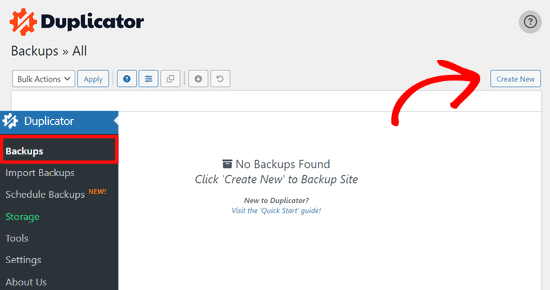
Duplicator inizializzerà ora la procedura guidata posteriore e assegnerà automaticamente un nome a questo pacchetto.
Fare clic sul pulsante “Avanti” per continuare.
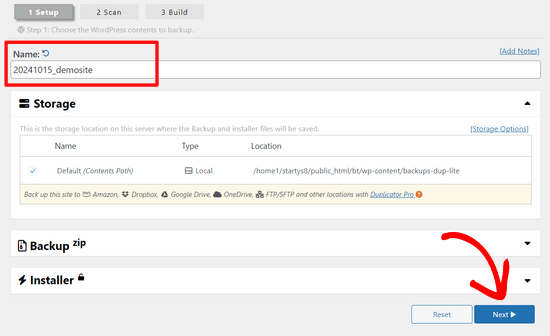
Duplicator eseguirà ora alcuni test per verificare se tutto è in ordine. Se il plugin trova un problema, verrà visualizzato un avviso con le istruzioni.
Se tutti gli elementi sono contrassegnati da “Buono”, fare clic sul pulsante “Costruisci”.
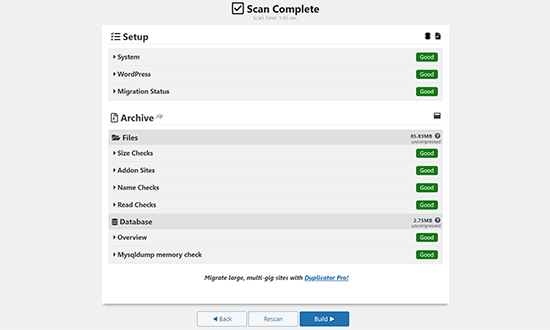
Il plugin inizierà a creare un pacchetto Duplicator dei file del sito web. A seconda delle dimensioni del sito, questo processo potrebbe richiedere alcuni minuti.
Una volta terminato, verrà visualizzata l’opzione “Download”. Facendo clic su di essa, si potrà scegliere di scaricare entrambi i file o di scaricare il programma di installazione e l’archivio (zip) separatamente.
Scegliere “Scarica entrambi i file” per scaricarli sul computer.
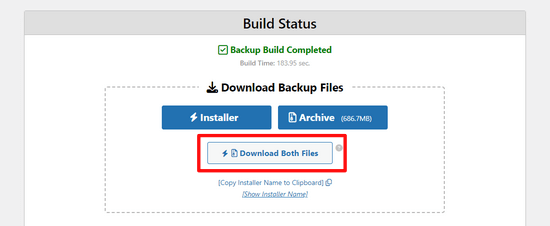
Il file di archivio è una copia completa dei file di WordPress. Include i temi di WordPress, le impostazioni dei permalink, i plugin, i caricamenti e qualsiasi altro file creato dai plugin di WordPress.
Lo script di installazione è un file PHP che automatizza ed esegue la migrazione di WordPress scompattando il file di archivio.
Fase 2: Creare un database per il nuovo nome di dominio
Prima di spostare il vostro sito WordPress sul nuovo dominio, avrete bisogno di un nuovo database SQL per disimballare WordPress sul nuovo nome di dominio.
Se avete già creato un database, potete saltare questo passaggio.
Per creare un database, è necessario visitare la dashboard del cPanel del proprio account di hosting, scorrere verso il basso fino alla sezione “Database” e quindi fare clic sull’icona“Database MySQL“.
Vi mostreremo come individuarlo su Bluehost, ma le istruzioni di base sono le stesse e dovrebbero valere per tutti i provider di hosting.
Accedere al cruscotto del proprio account Bluehost e fare clic sul pulsante “Impostazioni” sotto il proprio sito web.
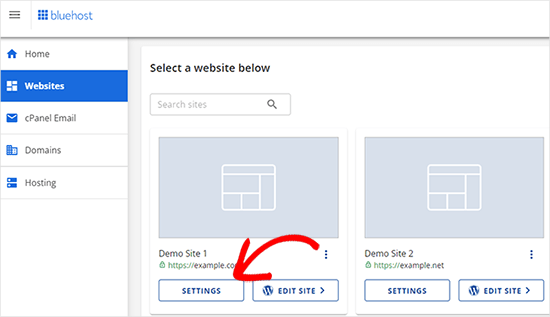
Nelle impostazioni del sito, è necessario passare alla scheda “Avanzate”.
Scorrete un po’ in basso fino alla sezione cPanel e fate clic su “Gestione”.
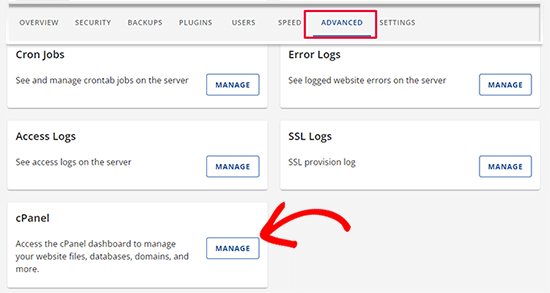
Si aprirà il cruscotto di cPanel.
Scorrete la sezione Database e fate clic sull’opzione “Database MySQL”.
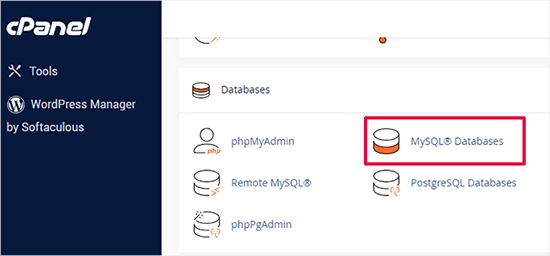
Nota: il pannello di controllo del vostro hosting potrebbe avere un aspetto leggermente diverso da quello delle schermate. Tuttavia, dovreste essere in grado di trovare una sezione Database con un’opzione per creare un nuovo database.
È sufficiente indicare un nome per il database e fare clic sul pulsante “Crea database”.
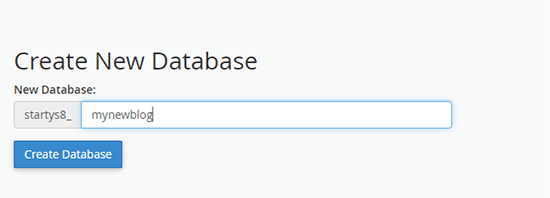
cPanel creerà un nuovo database per voi. Dopodiché, è necessario scorrere verso il basso fino alla sezione Utenti MySQL.
Quindi, fornire un nome utente e una password per il nuovo utente e fare clic sul pulsante “Crea utente”. Assicuratevi di annotare il nome utente e la password in un luogo sicuro.
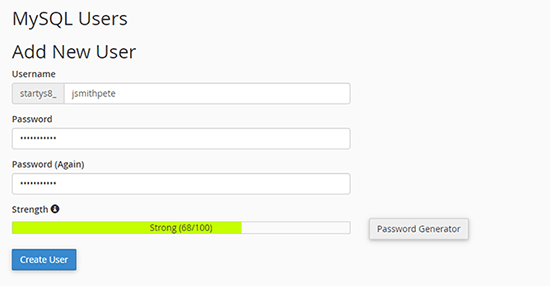
Il nuovo utente appena creato non ha ancora il permesso di lavorare sul database. Modifichiamo la situazione.
Scorrere fino alla sezione “Aggiungi utente al database”. Per prima cosa, selezionare l’utente del database creato dal menu a discesa accanto al campo “Utente”. Quindi selezionare il nuovo database appena creato e fare clic sul pulsante “Aggiungi”.
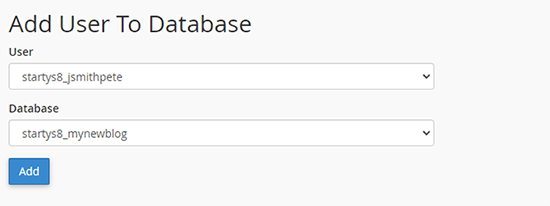
Successivamente, vi verrà chiesto di scegliere i privilegi per l’utente.
Selezionare “Tutti i privilegi” e fare clic sul pulsante “Apporta modifiche” per continuare.
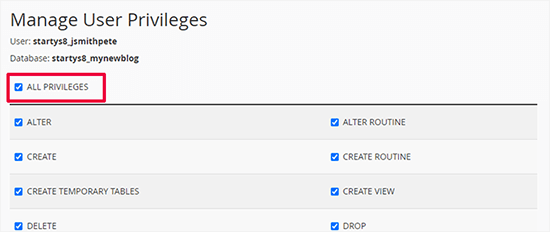
Il database è ora pronto e può essere utilizzato per spostare WordPress sul nuovo nome di dominio.
Assicuratevi di annotare il nome del database, il nome utente e la password. Queste informazioni vi serviranno nella fase successiva.
Fase 3: Disimballare WordPress sul nuovo nome di dominio
Ora è necessario caricare i file di Duplicator scaricati in precedenza sul nuovo nome di dominio.
Il pacchetto Duplicator include anche l’installazione di WordPress. Ciò significa che non è necessario installare WordPress sul nuovo dominio.
Per prima cosa, collegatevi al vostro nome di dominio utilizzando un client FTP. Una volta collegati, assicuratevi che la directory principale del vostro sito web sia completamente vuota.
Dopodiché, è possibile caricare i file dell’archivio e del programma di installazione nella directory principale. Questa è solitamente chiamata public_html.
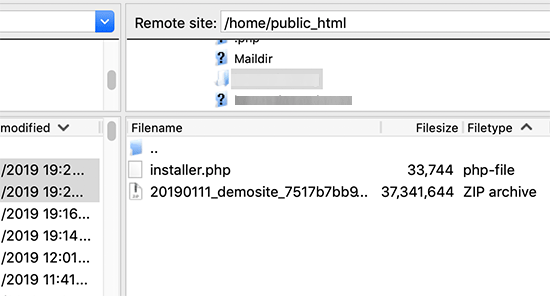
Una volta che entrambi i file hanno terminato il caricamento, siete pronti a scompattare WordPress.
Aprite una nuova scheda del browser e visitate il seguente URL:
http://example.com/installer.php
Non dimenticate di sostituire example.com con il nuovo nome di dominio. In questo modo si avvierà la migrazione guidata di Duplicator.
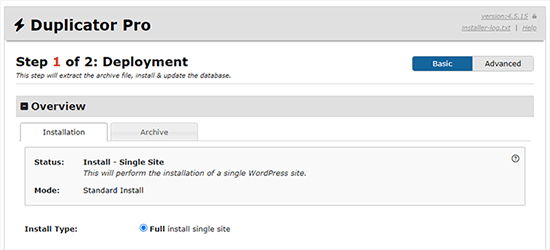
Il programma di installazione cercherà il file di archivio e selezionerà automaticamente le opzioni sullo schermo.
Scorrete un po’ in basso per inserire le informazioni relative al database creato nel passaggio precedente.
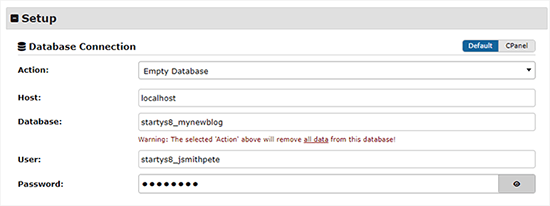
Di seguito, Duplicator mostrerà automaticamente l’URL del vecchio dominio e del nuovo dominio.
Se tutto sembra a posto, fare clic sul pulsante “Convalida” per continuare.
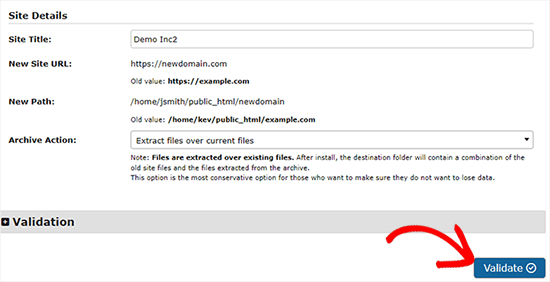
Duplicator tenterà ora di connettersi al database utilizzando le informazioni fornite.
In caso di successo, verrà visualizzato un Passaggio di convalida. In caso contrario, verrà visualizzato un avviso con i dettagli su come risolvere il problema.
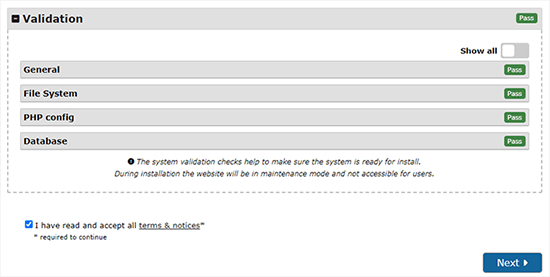
Fare clic sul pulsante “Avanti” per continuare.
Duplicator inizierà a importare il vostro sito web WordPress. Al termine, verrà visualizzato un messaggio di successo con un pulsante di accesso all’amministrazione.
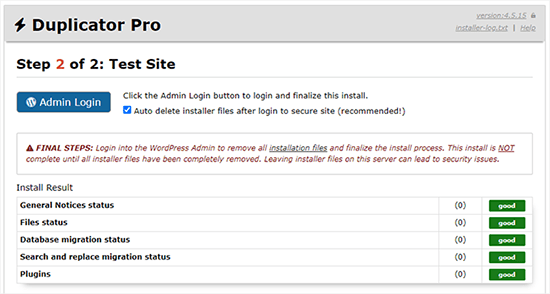
Duplicator aggiornerà automaticamente gli URL al nuovo nome di dominio. Ora è possibile fare clic sul pulsante “Accesso amministratore” per completare le fasi successive.
Passo 4: Impostare reindirizzamenti 301 permanenti
Il passo successivo è quello di indirizzare gli utenti che arrivano sul vecchio nome di dominio verso il nuovo dominio. A tal fine, è necessario impostare i reindirizzamenti 301.
I reindirizzamenti 301 sono molto importanti per la SEO e l’esperienza utente. La loro aggiunta consente di reindirizzare automaticamente gli utenti e i motori di ricerca verso il nuovo nome di dominio.
In altre parole, ogni volta che qualcuno approda a un post o a una pagina del vostro vecchio dominio, verrà automaticamente reindirizzato allo stesso post o alla stessa pagina del vostro nuovo dominio, invece di visualizzare un errore 404.
Per mantenere i reindirizzamenti, è necessario mantenere attiva la vecchia installazione di WordPress, in modo che possa continuare a reindirizzare alla nuova appena creata.
Esistono due modi per impostare i reindirizzamenti. Il primo metodo è semplice e richiede solo pochi clic. Il secondo metodo richiede la modifica manuale dei file.
Metodo 1: Impostare i reindirizzamenti 301 con All in One SEO
Per questo metodo, avrete bisogno di All in One SEO (AIOSEO). È il miglior plugin SEO per WordPress sul mercato e vi permette di ottimizzare facilmente il vostro sito web WordPress per la SEO.
Innanzitutto, è necessario installare e attivare il plugin All in One SEO sul vecchio dominio. Per maggiori dettagli, consultate la nostra guida passo passo su come installare un plugin di WordPress.
Nota: per accedere all’addon per la gestione dei redirect è necessaria almeno la versione Pro del plugin. Potete anche impostare AIOSEO sul vostro nuovo sito WordPress per incrementare ulteriormente il posizionamento sui motori di ricerca e il traffico.
Dopo l’attivazione sul vecchio dominio, è necessario visitare la pagina All in One SEO ” Reindirizzamenti e fare clic sul pulsante “Attiva reindirizzamenti”.
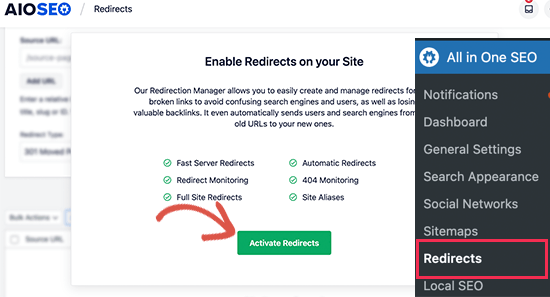
Successivamente, è necessario passare alla scheda “Reindirizzamento completo del sito” e attivare la levetta “Ricolloca sito”.
Dopodiché, è necessario inserire il nuovo nome di dominio accanto all’opzione “Trasferire su dominio”.
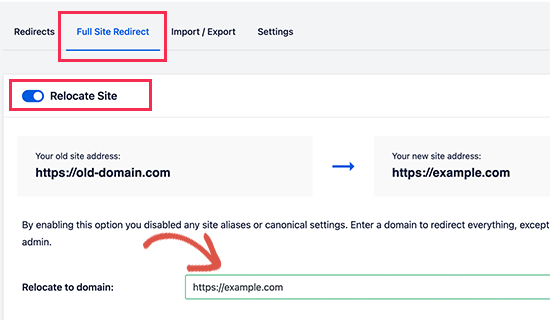
Non dimenticate di fare clic sul pulsante “Salva modifiche” per memorizzare le impostazioni.
Metodo 2: Impostare manualmente i reindirizzamenti al nuovo dominio
Questo metodo richiede la modifica del file .htaccess di WordPress sul vecchio nome di dominio.
Per prima cosa, è necessario collegarsi al vecchio sito tramite FTP e modificare il file .htaccess.
Questo file si trova nella stessa cartella di wp-includes o wp-admin. Aprite il file .htaccess e incollate le seguenti righe di codice all’inizio:
1 2 3 | #Options +FollowSymLinksRewriteEngine onUnchanged: RewriteRule ^(.*)$ http://www.newsite.com/$1 [R=301,L] |
Assicuratevi di sostituire newsite.com con il vostro nuovo dominio nel codice sopra riportato.
Una volta applicate queste modifiche, visitate il vostro vecchio nome di dominio. Dovrebbe reindirizzarvi automaticamente al nuovo dominio.
Se non lo fa, significa che il reindirizzamento non è impostato correttamente e che il vostro server probabilmente non supporta le regole di reindirizzamento. È necessario contattare il team di assistenza della società di web hosting per attivare RewriteEngine.
Passo 5: notificare a Google il nuovo dominio
Ora che avete spostato WordPress su un nuovo nome di dominio e avete impostato i reindirizzamenti, è il momento di notificare a Google il vostro cambio di indirizzo. In questo modo Google troverà rapidamente il dominio del vostro nuovo sito web e inizierà a mostrarlo nei risultati di ricerca.
Innanzitutto, è necessario assicurarsi che il nuovo e il vecchio dominio siano aggiunti a Google Search Console come due proprietà diverse. Per le istruzioni, consultare la fase 1 della nostra guida a Google Search Console.
Successivamente, è necessario selezionare il vecchio nome di dominio come proprietà attiva nella dashboard dell’account di Google Search Console.
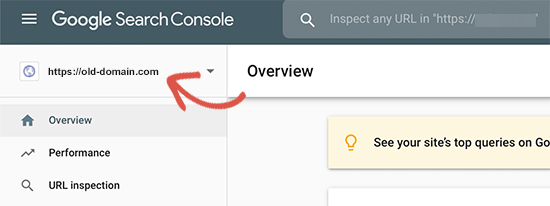
Successivamente, fare clic sul menu Impostazioni dalla colonna di sinistra.
A questo punto è possibile fare clic sullo strumento “Cambiamento di indirizzo”.
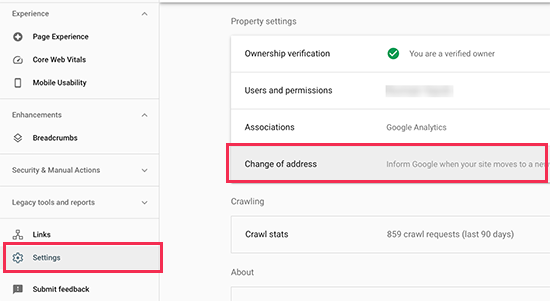
A questo punto, è necessario selezionare il nuovo dominio dalla sezione Aggiorna Google.
Quindi, si deve fare clic sul pulsante “Convalida e aggiorna”.
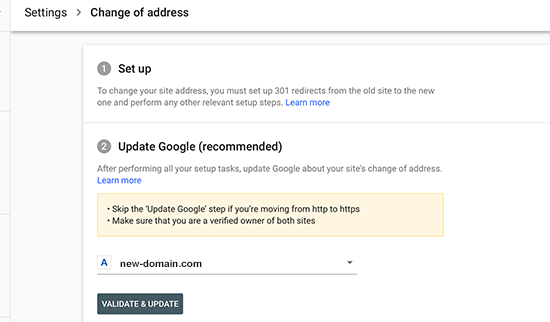
Questo è tutto. Google convaliderà ora che il vecchio dominio sta reindirizzando al nuovo dominio e salverà le modifiche.
Nella schermata successiva, Google Search Console vi mostrerà una procedura guidata passo dopo passo per inviare la richiesta di cambio di indirizzo.
Notificare agli utenti il nuovo nome di dominio
Mentre i reindirizzamenti 301 fanno il loro lavoro, è sempre bene fare un annuncio pubblico della migrazione.
Per farlo, è sufficiente scrivere un post sul nuovo sito e condividerlo sui propri account di social media.
Se avete una newsletter via e-mail o abbonati alle notifiche push, dovreste inviare un annuncio anche a loro.
Questo può essere utile in molti modi.
In primo luogo, è più probabile che i vostri utenti si ricordino del nuovo dominio una volta che lo hanno letto.
In secondo luogo, potete chiedere ai vostri utenti di farvi sapere se notano qualche bug. Da soli non potete testare il vostro sito in ogni tipo di browser o ambiente di sistema, quindi è sempre utile che un paio di occhi nuovi lo guardino.
Video tutorial
Risorse bonus
Gli articoli e le esercitazioni che seguono vi aiuteranno a monitorare e a recuperare le vostre posizioni SEO dopo la migrazione a un nuovo dominio:
- La lista di controllo definitiva per la migrazione SEO di WordPress (per i principianti)
- Come verificare se i post del vostro blog WordPress sono selezionati per le parole chiave giuste
- Come tracciare i visitatori del sito web in WordPress
- Suggerimenti per ottimizzare i post dei blog per la SEO come un professionista (lista di controllo)
Speriamo che questo tutorial vi abbia aiutato a spostare il vostro sito WordPress su un nuovo dominio. Potreste anche consultare la nostra guida su come ottenere un dominio email gratuito o seguire i passaggi della nostra guida completa sulla SEO di WordPress.
Se questo articolo vi è piaciuto, iscrivetevi al nostro canale YouTube per le esercitazioni video su WordPress. Potete trovarci anche su Twitter e Facebook.





WPBeginner Staff
We are not sure about this option, we haven’t tried it ourselves so we can not recommend it. Any redirection you set up needs to be 301 so that search engines can update the new location.
vikramforever
I have my domain with godaddy and they have redirect option with match path mentioned on their help page – http://support.godaddy.com/help/article/5120/redirect-urls-with-your-hosting-account.
Is this a feasible option when i transfer my active site to another domain? As per the option in the post, i need to maintain the hosting for my old domain till the time i want the redirects to work. Using redirect with the ‘match path’ option will do away the need to do so. But i want to be sure that this is an option which works the same way the script (as you mentioned) works.
Keely Worth
Excellent – makes the process of moving a WordPress site a breeze. Thanks.
Ayman
I’ve just migrate a website site from one URL to another. I would really like to thank you for this great post. 100% working and a very simple instructions
Anas Khan
Nice post. I have few questions too,
I have 2 blog on WordPress. The new blog is active and i have 45 posts in my new blog. The old blog has 192 posts and all posts are index on google.
Now i want to transfer and publish all old 192 posts to my new blog so all posts can me view on my new blog. If i trash all posts from my old blog, remove the sitemap and webmaster tool of old blog and after 30 days i publish old posts to new blog using Add new post button then it works ? Is it considered a duplicate content ?
WPBeginner Support
You can simply import those posts to your new blog and set up a 301 redirection on your old posts on a post by post basis.
Admin
Mohammed Saimon
Yes its a nice post. Thanks to the author.
Vinish Garg
This is an excellent post and gave me some new direction for moving my WP blog from one domain to another. I will appreciate if you can correct me if I am wrong in planning it as below.
– I know hostgator and I understand how to use File Manager and setup WP, database and import/export database (xml files)
– My current WP blog is at: http;//www.example.com, and I want to move it to another domain http://www.example.org.
– One, I will setup new WP at new domain’s root (database, config file, custom theme, and import data file from old site)
– The new site will show the site exactly like old site, BUT only difference is the URL (because of new domain).
If everything is correct this far… I am not sure how to use redirects for all my old domain’s pages/posts to new domain. Can you please advise?
WPBeginner Support
You can do that by following the step 3 of this guide, setting up 301 redirects.
Admin
Stefan
Great post, unfortunately I have read it too late and have already moved my domain. All I have done is I have purchased a new domain for my blog (, before it was it’s still active for another 2 months). I have changed the WordPress URL and Site Address in wordpress general settings and resubmitted the sitemap with the new URL. That’s all I have done.
This was one month ago and since then the traffic is now totally down, from more than 1,000 pageviews a day to now not even 200.
If I google search “thailand redcat” not even one of my pages shows up. The sitemap however has successfully been submitted:
2:51:35pmStefan
Do you know what could be the reason for this and how can I solve the problem and get the search results and eventually traffic back to normal again?
Any help would greatly be appreciated. Cheers!
WPBeginner Support
Stefan, we are not sure we understand the process you followed to move your site to a new domain. Here are some general tips. First make sure search bots are able to crawl and index your site? Check your site in Google webmaster tools for crawl errors.
Admin
Charlie
I have the same problem. Google crawlers find a 500 error on the whole site since is did the migration. I tried on 2 different environments/providers, different php versions, I tried to deactivate/reactivate all my plugins one by one, I tried to regenerate the permalinks, the htaccess, the robots.txt… nothing works.
Mr Joy
Thank you for your great post. I followed your post and moved my site to new domain. It’s all working fine but there is only one problem in my site regarding WordPress visual editor. The problem is “When I upload an Image on any post by Add Media option, then click on the picture thumble “edit image” an iFrame come with a Not Found Error. But when click delete it works fine. Please help me to resolve the problem. Check the screenshot : http://bit.ly/1fqjE1b
WPBeginner Support
The first thing you can try is to update your permalinks, simply go to Settings » Permalinks and click on the save changes button.
Admin
AP
Excellent work – thanks very much! It might be helpful to add the reply above – the one dealing with new database creation and use – to the initial instructions, as not everyone will read the comments before attempting a transfer.
Gary Kirwan
Great article. My question is I use the affiliate cloaking method recommended by Yoast, which means I have a .htaccess file under a folder called /out/
Would I need to add the same 301 redirect code mentioned in the article to both .htaccess files in the root directory and affiliate links sub-folder? Does adding the 301 redirect code to the root directory .htaccess file only automatically cover the sub-folders one?
My goal is to make sure that external affiliate links work correctly as well.
Kingsley
Great tutorial, will be using it to Migrate http://www.ideacrunch.org to http://technblogging.com in the next few days but i have a question to ask. The database password and username name will it be the same as the old site?
Craig
Hi, appreciate this is a little late. But i literally just want to move from http://www.unlockworldtv.co.uk to http://www.unlockworldtv.com is this tutorial suitable for that? I am not moving hosts, just changing the url
WPBeginner Support
Yes it is.
Admin
Craig
Thanks. I’m stuck at the go to newsite.com/installer.php I just get my old site but with 404. I didn’t install wp in the new directory, just created an empty directory to put the installer and zip in. I am pointing my new domain from the registrar account to that new directory with my web host but not getting anything but the theme and 404. Any obvious tips?
Craig
just FYI i resolved this. It appears to be an issue with 1&1 (no surprise) but can be resolved by having an index.html file present. So for anyone on 1&1 adjust step 2 from
“Make sure that the root directory, or the directory where you want to copy your website is completely empty.” to “Make sure that the root directory, or the directory where you want to copy your website is completely empty except for installer.php, the .zip file AND an index.html page”
I believe this is to do with the way 1&1 prioritise pages on their server.
Denis Fitzgerald
Hi – Thanks for the article. I have a question: I am switching my site from Tumblr to WordPress. It has its own domain. I would like to know if the buttons at the end of each article showing social shares, Twitter, Facebook, Google+, will maintain the original share count or go back to zero. Thank you.
WPBeginner Support
If its the same domain and your URL structure remains intact, then hopefully you will be able to retain those social counts.
Admin
Bertjan
Excellent guide! Thank you very much.
Sudha Mathew
Hi, I moved my site using redirects about 6 months ago and it works fine. I need to renew my contract with web security company soon. So I need to know how much traffic is still getting redirected from the old site. Could you explain how to do that? I am not tech savvy but can use both Webmaster tools and Google Analytics.Thanks in advance!
Best
Sudha
Moti
Hello,
I would like to change the domain name of my site (staying on the same host).
In the instructions above it is indicated that I should “make sure that the root directory, or the directory where you want to copy your website is completely empty.”.
In my case the WP is installed in the root directory (I have the wp-content folder under public-html) – I assume that this means that my WP is installed under the root directory.
Which folders should I clean / delete before I run the installed file generated by the duplicator ?
Thanks,
Moti.
Declan
Thank you for the tutorial. Worked great with no problems whatsoever.
I do, of course, have a question regarding SEO.
My old site wasn’t registered in Google webmaster tools, so obviously there’s no option to let them know about the changes I’ve made. My question is: Will I need to register my old domain with Google webmaster tools first, and then my second domain…and then notify them abut the changes?
Any thoughts would be great.
Thanks again for the article, it was extremely helpful.
Declan.
WPBeginner Support
Yes, you will have to notify about the change on your old site’s webmaster tools account. However, this is just the fastest way to do it. If you have setup your 302 redirects then search engines would pick that up as well.
Admin
reza
hi,
this works just great, i redirect my old.com which is my main domain to new.com which is an addon domain (in the same hosting)
but when i added another new addon domain, it makes my new addon domain can’t be accessed….it always redirect my addon.com to new.com/addon.com…
can you help ??
Jennifer @ Delicieux
Thank you for explaining this in so much detail. I have a question though. I’ve been thinking about moving to a new domain name for some time, but I wanted to know if I would have any issues given the fact that earlier in the year I changed the permalink structure on my old blog.
I followed the instructions on Yoast on how to change my permalink structure and edited my .htaccess file, and wonder if this will cause problems when I move to a new domain? This is the one thing that is holding me back because I don’t want things to screw up and lose rank and end up with broken links.
WPBeginner Support
you can transfer your old .htaccess file to your new site. If the .htaccess file has any references to the old domain name then replace those with the new domain name and your would be OK.
Admin
Hrayr
Hey,
First of all many thanks for this article – it worked great without any problem for me!
I have one simple question specific to my case, would highly appreciate your thoughts on this.
Basically i used this approach to copy my wordpress site from localhost to the host/domain from 3rd party.
As said all worked ok – i just want to make sure that this approach doesn’t leave any old urls/links/references that can “annoy” google to crawl this new site. My site is pretty basic, so in worst case scenario i can just recreate if there is any disadvantage of crawling/SEO when site is copied by duplicator.
Is there any known SEO issue of new site that you are aware of?
WPBeginner Support
We not aware of any SEO issues, but if you come across any you can inform the plugin author by opening a support thread on plugin’s page.
Admin
Kevin
I don’t think the way you suggest users do their 301 redirect is the best way. It’s well documented, even recommended by Google, that you do page-to-page redirects, NOT dump all your old website’s pages to the homepage of the new site. The htaccess code you provide does the latter. It isn’t a good way to preserve link juice.
Maybe you can refer us to a good htaccess tutorial instead? There are also online htaccess generators out there that can make it much faster to do page-to-page redirects.
WPBeginner Support
Kevin, you are right and rewrite rules in the article do exactly that. Instead of redirecting users to the homepage it sends them to the individual page. $1 at the end of code appends the link with the proper permalink structure.
Admin
Julian
Hi, when I’m doing this after ‘deploy’ it misses the ‘update’ section and reverts back to a 404 page at the old web address… any idea what could be causing this?
Many thanks!
Munna
Thank you very much for this post. I was in trouble redirecting my oldsite visitors to the new site. But your .htaccess code made it super easy because both sites were in the same hosting server.
Raspal
Hello,
I completed all the steps and the blog at the new site is up fine. But I can’t login to the admin area. I have two users, one is an admin user. I get this error when trying to login:
“ERROR: Cookies are blocked or not supported by your browser. You must enable cookies to use WordPress.”
I tried different browsers and also tried clearing any cookies. Also tried changing password. Password was changed fine but still getting the above error.
Can you please help ASAP?
Using WP version 3.7.1
Regards,
Raspal
Neil Bargas
Thanks man! 100% working and a very simple instructions.
Lynn
Fantastic article! You are my hero of the day.
Jahid
”Login to your new site’s WordPress admin using the same username and password that you had on the old site. Go to Settings » Permalinks in your new site’s WordPress admin and click on the save button.”
Once I login, it shows me the first step page ”Step 1: Files & Database” instead of showing the WP dashboard. Help!
WPBeginner Support
Seems like you need to update your wp-config.php file
Admin
Chrissy
Hi! Thanks so much for this helpful article – I’m in the process of running through the steps now.
My one question is:
I have my blog hosted at one domain, let’s call it http://www.reallylongdomainname.com/blog, but I have a redirect to forward it to my other domain: blog.shortername.com. I now want to migrate the blog to shortername.com/blog, because some of the links don’t work after the redirect.
All my posts and things already have permalinks at shortname.com/blog/post#, so do I really need to do any of this 301 stuff? Am I safe to skip steps 3, 4 & 5, or is there something I need to consider? And will I need to delete the old blog or just the redirect once I launch it at the new domain?
Would be really great to find out how to proceed, since I’ve tried dozens of things this week and no situation is quite the same as mine :/ Thanks!
WPBeginner Support
The purpose of 301 redirects is to not just redirect users but also let search engines know that you have moved to the new location so step 3 and 4 are a must otherwise it may affect your SEO rankings.
Admin
Mark P
Great post. One question though.
Let’s say someone clicks on a backlink for my website’s old domain. (Let’s call it olddomain dot com / blogpost1). Will this then redirect to the new domain’s respective link (newdomain dot com / blogpost1) instead of just redirecting to the new domain’s homepage?
WPBeginner Support
Yes, it would redirect users landing on your posts and pages on the old site to the posts/pages on the new site.
Admin
Mark P
Thank you!
Morgan
Question: I am switching my site from one host to a new host. At the same time, I am changing my domain name. I have already successfully transferred my WordPress site to my new host using the new domain name. I now am to step 3 and want to use 301 redirects to point those old URLs to the new site URLs. However, the old site is on the old host and I’m planning on getting rid of that site.
Will the 301 redirects still work? Or do I also need to move the old site over to my new host and THEN do the redirects? I’m a bit unsure what to do and would love any advice.
WPBeginner Support
If it is possible for you to keep the old site online for at least a month, then you can add 301 redirect. After that update your site’s information on Google Webmaster tools. Once you have recovered your search rankings and traffic you can then close your account with the old web host.
Admin
Nj
Thank you for the helpful posts, but sometimes with such plugins, a video will help A LOT. I hope you will consider this
Thanks again
Arnold
Hi. Could you please elaborate the part where you said “The installer will ask you to provide database information for the new site and check the box for Table removal?” Where do I find this database information? So should I check the box for Table removal? Thanks!
WPBeginner Support
This is the database where you will be importing your old site from the package you created earlier. Log into your web hosting dashboard, find phpmyadmin and create a new database. Come back to installer.php and provide the new database name, host, user and password.
Admin
Kara Lumsden
So you should not install wordpress on the root of the new domain? The only thing you need to do on the new domain is only create a new database, is that correct? Can you elaborate a little more on how to create the database in phpmyadmin?
So appreciative, thank you for all that you do!
WPBeginner Support
No it is OK to install WordPress on the root of the new domain. Yes, you just need to create a new database and the Duplicator takes care of the rest.
Kara Lumsden
Can you please provide instructions on how to create the database?
Thank you very much,
Kara
Dennis J. Smith
How long should one wait before deleting the old site?
WPBeginner Support
30 to 90 days, depends on how successful your move was. If you are confident that your new domain has gained nearly the same traffic as the old site, then you can delete it.
Admin
dyer
Hi ive encountered an issue. Im unable to save my Permalinks as I cant locate the WP admin file ive tried to upload the WP admin file again but this hasn’t the issue please could you advise me if there is any other steps I can take to rectify this issue.
Thanks
Dyer
WPBeginner Support
@dyer We are unable to understand your question. We are assuming that you can not access your WordPress Admin area. In that case, connect to your site using an FTP client like filezilla. Find the file
.htaccessdownload it to your hard disk and delete it from your website. Hope this resolves your issue.Admin
Fakhre
Thanks for the article guys!
I am hosting my site on Bluehost and just want to change the Domain name without loosing the SEO and backlinks.
My site contents is huge, i have about 8000 posts. Any solution for renaming the domain??
Sanjay Patel
Hello…
Really useful information but duplicator plugin is not working in my website. please solve my problem. how to do this?
Thanks in advance.
Dinah
Does this work with moving from one domain to a subdomain?
Editorial Staff
Yes
Admin
Dinah
Does this work for moving to a new subdomain? Like if my wordpress blog was on oldsite.com and I wanted it on blog.newsite.com, would I do the same thing?
Editorial Staff
Yes.
Admin
Emmie
I recently did this and the links and all redirected fine and dandy, however I just got slapped by Google with a penalty for instantly having so many backlinks – they think I bought them. Has anyone else encountered this? I made the appropriate notifications in Google Webmaster tools before moving, and it’s done nothing to help this. It’s hit me hard, so if anyone has experience in remedying this, please share!
Editorial Staff
Hey Emmie, where do you see that you get slapped for having too many backlinks? Does it show you that error in your Webmaster Tools? Just trying to see how did you come to the conclusion that you got penalized by google.
https://www.google.com/webmasters/tools/reconsideration << This is the page where you can send a reconsideration request to Google.
Admin
Lateef Adewale
Do you have any idea if this will work if i am moving a site from Bluehost to Wp Engine.
Editorial Staff
Yes it should work.
Admin
Emily
Just went through this whole process, worked perfectly and just what I needed to know. Thank you WPBeginner! The only glitch I ran into was my own fault – didn’t deactivate my security plugins first so I had to do it all over. Now, I am an expert… : )
Sandra Christie
Thanks for the article!
Are the steps for moving the same domain to a new host basically the same? And can that cause a drop in SEO as well?
Travis Pflanz
As well, the “Change of Address” option in Webmaster Tools is now in the Options menu at the top right in in Gear icon.
Zach Smith
Thanks for publishing another great article for us. This is best for any technology related blog.
Bob
Thanks–this is great information. I’m really excited to learn about Duplicator. While moving a domain is something I might have to do occasionally, I’m constantly cloning environments for development and testing purposes. The manual cloning process I’ve been using is time-consuming and potentially error-prone. Duplicator has the potentially to be a considerable improvement!
Sam
I just moved WP to a new domain and server using this method. Webmaster Tools now shows many 403 errors on the new server for each folder in uploads such as wp-content/uploads/2012/07 and one 403 error for each of the months. On my old server I did not get this. When moving the site should we also change or check the permissions? What should they be for the wp-content/uploads folder?
Editorial Staff
Google should not be indexing the folders rather they should be indexing the files inside of it. If you try to access the folder directly using a browser, WordPress will give you a 404 error. You don’t want to allow access to a directory that has no index page, which will then produce a directory listing that will get indexed and crawled, including the links to all files.
Admin
sam
Thanks for the reply. Then why does Google show a 403 error for the folders in webmaster tools. Does this not mean that something is wrong?
Zimbrul
THIS IS THE ARTICLE I WAS LOOKING FOR 1 YEAR NOW!!
Editorial Staff
Better late than never
Admin
Jasim Ahmed
Duplicator is great plugin but problem is its not work with some server as its need higher PHP version except this is there any other way to do ?
Editorial Staff
Yes, you can manually download the files and the database. Upload them on the new domain. Replace all the old url instances in the database using phpMyAdmin SQL search and replace query. The easier solution would be to ask your host why they are not on the higher versions of PHP or switch to a better host.
Admin
iAn
hi, I believe this won’t preserve your social network network sharing counters (number of shares and likes). Any idea how to retain those popularity meter?
Editorial Staff
You can’t retain the social counts because those go based on your canonical URLs which will be the new site (very important for SEO). The counters are mainly for social proof. All existing links in social media will properly redirect, so you won’t lose any traffic there.
Admin